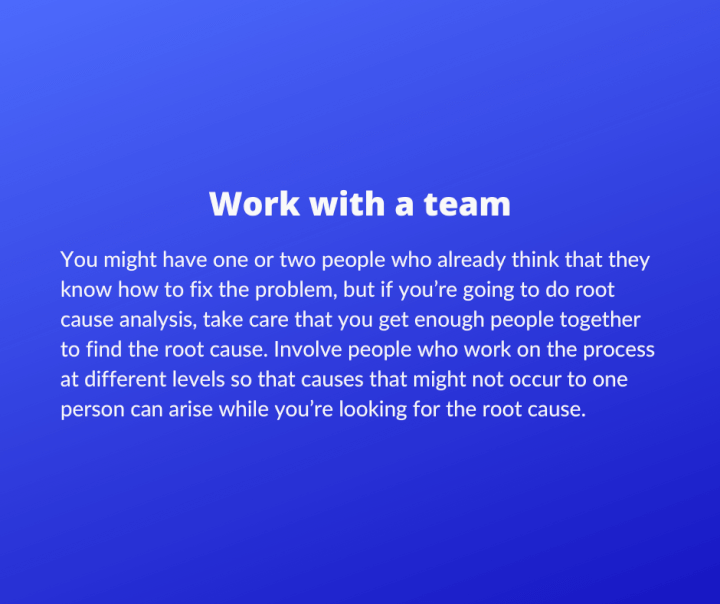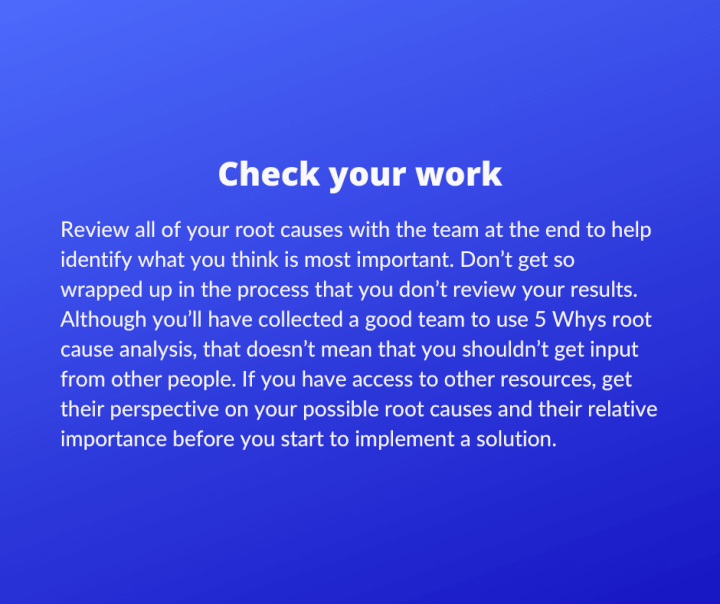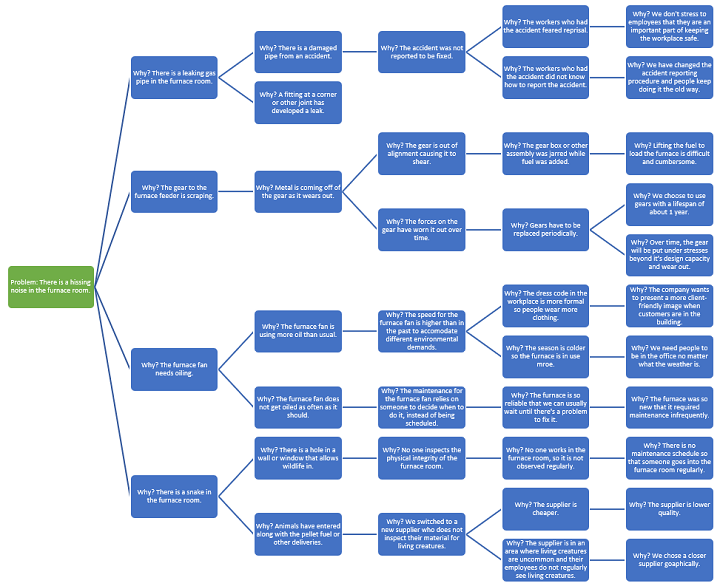Lean Six Sigma
6 minute read

5 Whys - What They Are & How to Use Them [Free Template]

Cody Steele
Twitter LinkedIn WhatsApp Pocket Email
What are the 5 Whys?
5 Whys is a Lean Six Sigma technique for refining a problem statement. In different situations, you might apply the technique to identify root causes, testable hypotheses, or to give a clear definition of a problem.
The simple description of 5 Whys root cause analysis is that you ask “Why?” you are having a problem. Then, you answer the question, then ask “Why?” again.
By the time you have asked “Why?” the right amount of times, you should have an idea about how to proceed to solve the problem.

As with many Lean tools , 5 Whys root cause analysis is generally believed to have evolved alongside the rest of the Toyota Production System (TPS). Root Cause Problem Solving (RCPS) encompasses several other tools, such as Failure Modes and Effects Analysis (FMEA) and Ishikawa diagrams (sometimes called fishbone diagrams).
Download your free 5 Whys template
Use this 5 Whys template to get started with your own 5 Whys root cause analysis.
When to use 5 Whys
5 Whys root cause analysis is a useful tool anytime that the statement of a problem does not immediately reveal its solution.
Frequently, the absence of a solution is because the initial problem statement is a symptom of an underlying problem that has not been clearly identified or stated. The 5 Whys root cause analysis gets you to the real problem so that you can identify a real solution.
Simple 5 Whys example
A traditional example of 5 Whys root cause analysis follows a pattern like the following:
Problem: The engine stopped working.
- Why did the engine stop working? Because the engine overheated.
- Why did the engine overheat? Because the gears weren’t getting enough oil.
- Why weren’t the gears getting enough oil? Because the oil pump wasn’t feeding enough oil.
- Why wasn’t the pump feeding enough oil? Because the intake was clogged with metal shavings.
- Why was the intake clogged? Because the filter was worn out and needs replacing.
Tips for 5 Whys root cause analysis
This simple example illustrates two critical points about succeeding with 5 Whys root cause analysis.
1. Don’t stop too soon
In the simple example, we could see that the engine overheated and decide that the solution is to increase the amount of coolant going to the engine. Asking “Why?” until you reach the root cause is vital.
2. Find a solution
When you’ve identified the root cause, it should suggest a solution to the problem, or at least a hypothesis that you can test. If you don’t have an idea of what to do next, try to keep going.
How to use 5 Whys root cause analysis
Although you can use 5 Whys root cause analysis in both simple and complex situations, you’ll often need to use 5 Whys root cause analysis with difficult problems in complex processes. In such cases, keep in mind the following four principles.

1. Identify an important problem
The Pareto rule suggests the 80/20 relationship . Colloquially stated, 80 percent of your defects come from 20 percent of your problems. Take time to identify the most important problems first and solve those.
2. Work with a team
You might have one or two people who already think that they know how to fix the problem. But if you’re going to do root cause analysis, take care that you get enough people together to find the root cause.
Involve people who work on the process at different levels so that causes that might not occur to one person can arise while you’re looking for the root cause.

3. Broaden your search
In the simple example, there was only one answer to each “Why?” question, but that’s not a requirement. For many processes, especially if you have a diversity of perspectives, you can even arrive at multiple root causes. Capture this thinking in your analysis.
4. Check your work
Review all of your root causes with the team at the end to help identify what you think is most important. Don’t get so wrapped up in the process that you don’t review your results.
Although you’ll have collected a good team to use 5 Whys root cause analysis, that doesn’t mean that you shouldn’t get input from other people. If you have access to other resources, get their perspective on your possible root causes and their relative importance before you start to implement a solution.

5 Whys diagram
As your problems and processes become more complex, it’s helpful to have a 5 Whys diagram or 5 Whys template that you can use to get started.
For a complex process or for a problem with many possible root causes, a 5 Whys diagram can become quite large. The point of the process is not to be neat. However, it’s to identify root causes and to help you arrive at solutions. To do that, you need to be thorough in your search. Here’s an example of what a 5 Whys diagram might look like in a moderately complex case:

5 Whys root cause analysis is only one way to do root cause analysis and only one of many tools that can help you get the most from your projects and processes.
To learn more Lean Six Sigma skills and tools, check out GoSkills range of courses , designed to prepare you for certification with IASSC/PeopleCert.
Prepare to get certified in Lean Six Sigma
Start learning today with GoSkills courses
Loved this? Subscribe, and join 441,261 others.
Get our latest content before everyone else. Unsubscribe whenever.

Cody is a technical communicator and statistician who wants to help people collect the right data and analyze it to make informed decisions. His specialities include statistics, technical communication, statistical reliability, JMP, SAS, and writing for translation.

Recommended
How Online Learning Can Help You Grow Professionally (and Personally)
To grow professionally doesn’t just mean climbing the corporate ladder. Explore four ways online learning fosters professional, and even personal, growth.

Process Improvement Skills Boil Down to These 3 Elements
How can you tell someone has process improvement skills? It really comes down to a combination of three important factors.

The Basics of Gage R&R
Gage Repeatability and Reproducibility studies (Gage R&R) are a type of Measurement Systems Analysis (MSA). This tutorial walks you through the basics.
© 2024 GoSkills Ltd. Skills for career advancement

IMAGES
VIDEO
COMMENTS
In such cases, keep in mind the following four principles. 1. Identify an important problem. The Pareto rule suggests the 80/20 relationship. Colloquially stated, 80 percent of your defects come from 20 percent of your problems. Take time to identify the most important problems first and solve those.